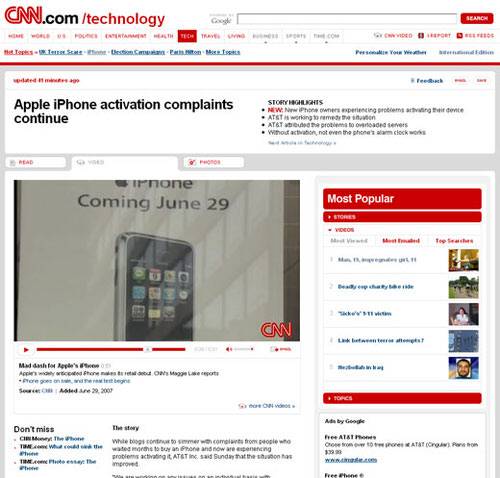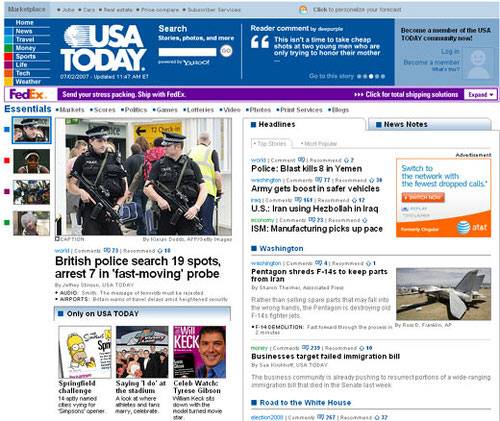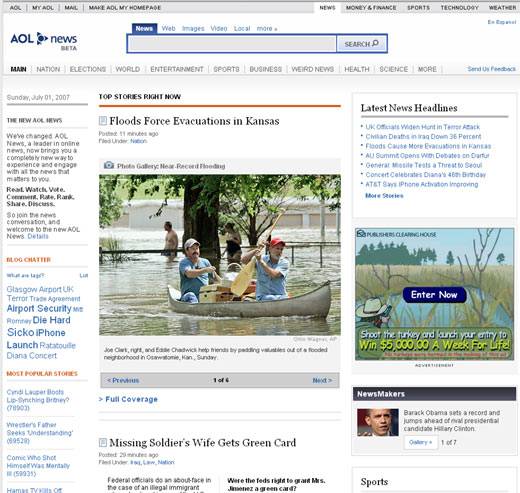Newspaper circulation has been on the decline over the past few years, but the traffic to newspaper websites continues to rise. Interestingly, the area of newspaper websites that has experienced the most growth is blogs, perhaps proving that new media formats are beginning to usurp old media in earnest.

As we reported on Saturday, CNN.com went live with a redesigned version of their website over the weekend. I thought it might be interesting to compare three big media sites that have launched new versions of their web news properties in 2007: CNN (redesigned this weekend), USA Today (redesigned in March), and AOL News (redesigned last week). I’ll look at the different approaches each news outlet took, and what cues they took from web 2.0.
CNN
CNN‘s relaunched design is much cleaner and easier to read than their previous site. It has softer, rounded corners, lighter-colored and larger link text, and a less-busy header. The new sites also integrates text, photo, and video a lot more smoothly than on their previous site, making use of AJAX so that visitors can switch between different types of media without reloading the page.
The site has placed a greater focus on video and photos, relaunching with a new flash video player and an attractive flash slide show. The focus on multimedia is really no surprise. YouTube has demonstrated just how important video is becoming to today’s Internet users, especially in terms of attracting the attention of younger visitors. Further, because Flash has made it possible for people to load relatively high quality video quite quickly, it is no longer an encumbrance for users, but a valuable feature. This has allowed CNN the opportunity to emphasize video and tie their web presence more closely to their core property: their television news network.

The redesigned CNN has a few other features straight out of web 2.0. Their updated “Most Popular” box includes the most viewed, emailed, and searched for stories and videos, as well as the most popular topics. It uses AJAX effects to smoothly load each without need for a page reload. Taking a cue from Amazon, CNN has added a “We Recommend” feature that suggests stories based on your past browsing history. The site is so new it’s had to tell how well it works, though — it just doesn’t have much history to go on. CNN also has added commenting to their stories, though in practice I have seen it on very few.
Along with video, CNN now more greatly emphasizes their blogs and podcasts. And today they also launched free live video, though it requires downloading a special plugin.
USA Today
The design of the new USA Today site puts a lot of emphasis on images (surprise, surprise), and uses much larger text for headline links. The design can take some time to get used to, but it does an excellent job of drawing your eye to the lead stories. The new design also places an emphasis on blogging by placing USA Today’s “On Deadline” blog directly in a tab on the main page next to the day’s top headlines (it’s in the “News Notes” tab).
USA Today does two social features better than anyone else: commenting and voting. Every story on the site, including wire stories, have commenting enabled, and usually people have left comments. Many stories on USA Today attract in the hundreds of comments, making this relatively new feature of their site easily as popular as top blogs that have had commenting enabled for years. Users of USA Today’s site can also vote for stories by clicking on the “Recommend” button. This social recommendation feature powers story recommendations throughout the site.

Another page USA Today borrows from the web 2.0 playbook is tagging. In the middle of every story readers will see a line that starts with “FIND MORE STORIES IN:” These are tags, which editors have assigned to stories, and clicking on them will bring you to other stories tagged with the same term. USA Today has also embraced social news by adding Digg, del.icio.us, Newsvine, Reddit, and Facebook buttons to all their posts.
Finally, USA Today’s relaunch added social networking to the site. Not only can registered members comment on stories, but they also get their own profile and blog, and can upload photos, send messages, and make friends. The social networking features on the site are powered by Pluck, which powers social features for a number of newspaper properties, though none quite so well integrated as on USA Today.
AOL News
AOL News‘ redesign is probably the most radical departure, design-wise, from a traditional newspaper site. Taking a cue from blog design AOL relaunched their news site with less stories on the main page. Right now, for example, the main page shows only six full stories, displayed stacked one on top of the other like a blog. The sites includes headline boxes on the left side column, so the main page actually does show more news than just the blog-style center column.
Further borrowing from blogs, AOL News now supports comments. In practice, however, like CNN I actually found very few stories with commenting enabled. Even some of the stories listed as the most commented on didn’t seem to have comments. One thing that was evident on nearly all stories was the social media buttons that let people easily add stories to Digg, del.icio.us, Newsvine, Technorati, Reddit, Ma.gnolia, Blinklist, Furl, and of course: Netscape. Results from Netscape are actually listed in the left-hand column on the main site in an effort to tie AOL’s mainstream news site with its social news property.

Also included in that column is a tag cloud search that links to the most popular topics on blogs according to Sphere. Further, many of AOL’s stories include a thumbs up/thumbs down rating widget, though like comments the widget doesn’t seem to appear on every story, and I’m not really sure what, if anything, it does.
AOL’s embrace of blog culture seems to only go skin deep. The inconsistencies surrounding mainstay blog features, such as commenting, make the site feel a bit disjointed and frustrating to use.
Conclusion
AOL News, USA Today, and CNN are not the only news sites getting in on the web 2.0 act. Many others have embraced various aspects of the new social media landscape. The New York Times added social news sharing buttons to all of its articles last fall, for example, and just about every major news outlet has added blogs to their repertoire in the past couple of years. What do you think of the approaches taken by the three sites profiled above? Does it make sense to emphasize video like CNN? Does USA Today have it right by strongly pushing interaction between its readers? Or is the increasingly more popular blog-style design, a la AOL News, the way to go?
My feeling is that while CNN likely has the most attractive and professional-looking site (they could certainly win some web 2.0 design awards), USA Today has social media down cold. The fact that their users have embraced commenting and rating on news stories so vigorously, so quickly such that every day there are at least two or three stories with in excess of 200 comments is amazing and an affirmation of a tactic that has clearly paid off. However, interestingly, in contrast to what the anecdotal evidence would seem to suggest, USA Today has seen a huge drop off in traffic since their redesign went live in March according to Compete. It’s too early to tell how the new site designs will impact readership on CNN and AOL News. Leave you thoughts on the future of mainstream news on the web below.










